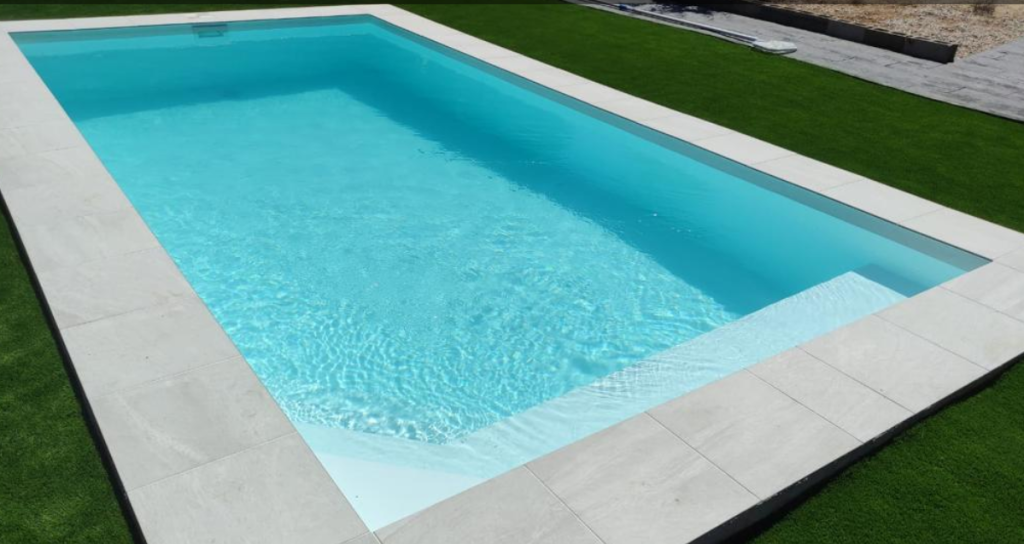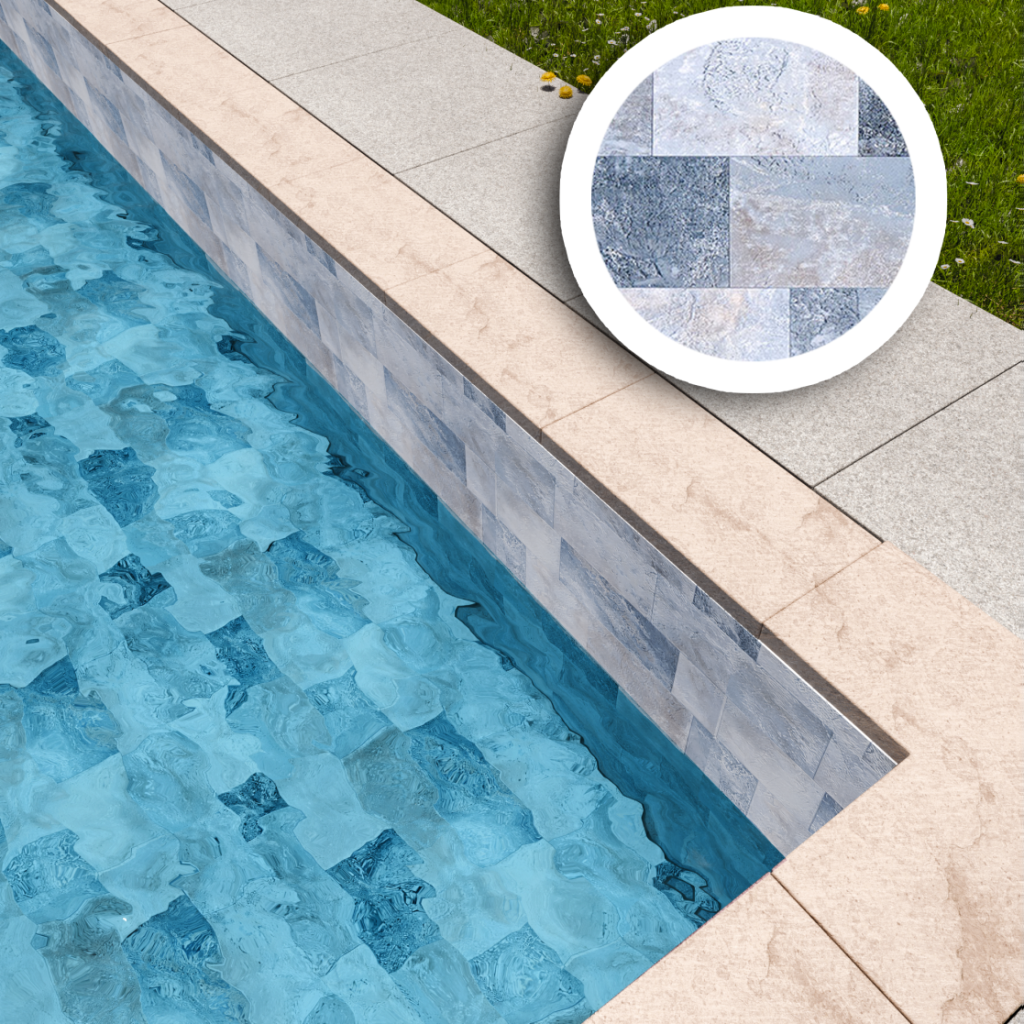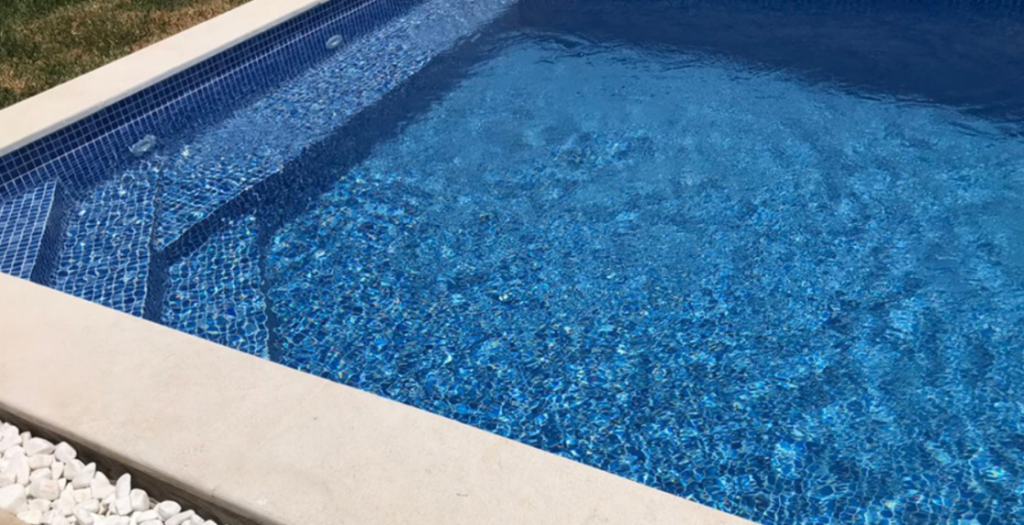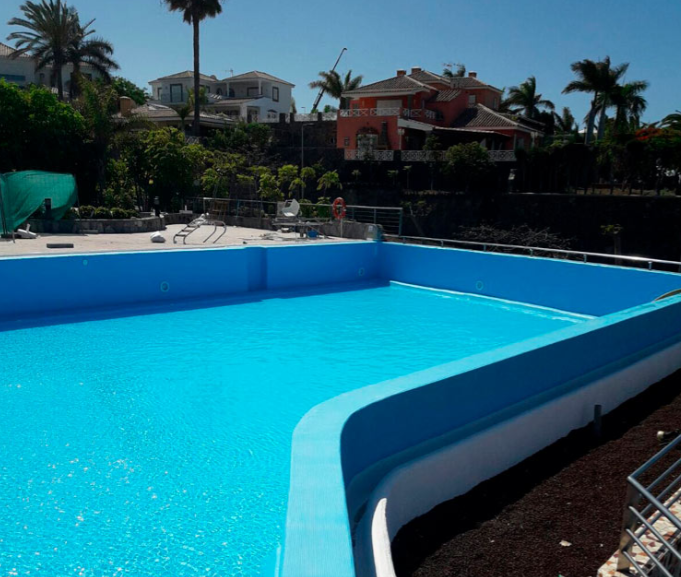In addition to the appearance of the pool, the factors of great importance to each owner include:
- cost of construction;
- speed of installation;
- complexity of maintenance and operating costs;
- maintainability;
- injury safety;
- service life.

A wide variety of materials are used for pool linings. Each of them has its advantages and its disadvantages. We can distinguish such types of pool finishes:
- Mosaic
- Plaster
- Pebble
- Water-resistant paint
- PVC membrane
Let’s take a look at one of these methods. It may seem like the quickest and most inexpensive way to clad a pool is to apply waterproof paint. But it’s not that simple.
- First, thoroughly prepare the pool shell. For concrete surfaces, all cracks must be repaired, irregularities smoothed out, and the surface completely cleaned by removing debris and dirt, then vacuuming the entire pool. Any defects left unaddressed will become highly visible after painting.
- Secondly, to ensure the paint adheres well, the pool surface must be thoroughly coated with a special primer. After that, the pool should be painted in 2–3 layers, with each subsequent layer applied only after the previous one has dried. Additionally, the air temperature during this process should not exceed 86°F, depending on the type of paint. The pool can be filled with water and used 5–6 days after painting—a considerable amount of time, wouldn’t you agree?
- Thirdly, the lifespan of such paint is only a few seasons. After that, all the steps must be repeated, which is neither cost-effective nor time-efficient.
Even with a method like painting with water-resistant paint, the process proves to be quite labor-intensive and challenging.
Why PVC 60 Mil Pool Liner Is the Top Choice
Each type of liner has its own advantages and disadvantages. But it so happens that the 60 mil pool liner for swimming pools miraculously combines the advantages of different types of liners. The use of vinyl liner guarantees:
- A smaller budget for materials compared to ceramic tiles, mosaics, plaster, and pebbles. While using the above materials may require “tons” (depending on the pool size), a PVC liner only needs a few rolls;
- High installation speed. Installing a 60-mil PVC liner is relatively quick, allowing the pool to be used almost immediately;

- Easy maintenance and low operating costs. Some PVC liners have a protective acrylic layer that resists fading and chemical exposure. Regular cleaning and monitoring the water’s chemical balance are enough to maintain the pool’s attractive appearance;
- Resistance to temperature fluctuations. A quality, thick liner can withstand both high and low temperatures, unlike tiles or mosaics, which can crack or fall off. This eliminates the need to drain water during the cold season, reducing operating costs;
- High strength and resistance to external factors. A thick, reinforced liner, like the Cefil 60 mil, maintains its tightness and prevents leaks even in case of cracks in the concrete basin. Cracks may result from ground subsidence, poor construction, or other factors. When using tiles, mosaics, plaster, pebbles, or water-resistant paint, draining the pool and performing expensive repairs are mandatory. With a PVC membrane, cracks are not critical, and the liner retains its waterproofing properties;
- Attractive appearance. The PVC membrane can be solid-colored or designed to imitate tiles, mosaics, or natural materials like marble, basalt, and sandstone. This flexibility makes it easy to match your surroundings or personal taste;

- Long life. A high-quality liner can last over 20 years with proper care, including periodic cleaning and maintaining the water’s chemical balance. So it’s up to you.
- Easy and quick replacement. When it’s time to replace the liner, it’s quick and easy. The old liner is removed, and a new one is installed, usually within a few days (depending on the pool size).

As you can see, PVC membrane is a very good alternative to traditional types of pool liners, combining the best features of other materials.
Where to Buy a High-Quality PVC Liner for a Swimming Pool
If you’re looking for a top-quality swimming pool membrane that will last for many years, SAKKO POOL specialists can help. The company offers membranes from a European manufacturer that meet all international quality standards for swimming pool liners. They will assist you in choosing the best solution, answer all your questions.

6 Comments
Logan Tinsley
Which pool will last longer – a fiberglass pool or one with a PVC membrane?
Konstantin Muraviov
Hi Logan! Fiberglass pools are long-lasting and easy to maintain. But there are points to consider. First, they are several times more expensive than PVC lining. Secondly, mechanical damage and the appearance of cracks after a very short time, which are very difficult and expensive to repair, are not excluded. Cracks can occur as a result of improper installation of the pool bowl in the ground. All this will immediately cross out all the advantages of the fiberglass pool.
A thick reinforced PVC membrane will last 20+ years with proper maintenance. It is also easy and simple to maintain, easy and cheap to repair, quick and inexpensive to replace when needed. Therefore, these types of pools are roughly equivalent in terms of life expectancy, but PVC pools end up costing significantly less in the long run with the same consumer qualities.
Shane Lockhart
Can chlorine damage PVC pool liners?
Konstantin Muraviov
Hi Shane! High concentrations of chlorine not only irritate the skin and eyes of swimmers, but also bleach and degrade the PVC liner. It is therefore necessary to regularly check and adjust the chemical balance of the water.
Jace Thornton
Can a fiberglass pool be converted to a PVC pool?
Konstantin Muraviov
Hi Jace! Yes, you can. It is inexpensive and quick. The shape of the pool and the presence of small cracks do not matter. The PVC membrane is laid on top, providing not only an attractive appearance but also complete protection against leaks.